Mobile:+86-311-808-126-83
Email:info@ydcastings.com
Hot Isostatic Pressing for Aluminum Castings
Hot Isostatic Pressing of Aluminum Castings Enhancing Quality and Performance
Hot Isostatic Pressing (HIP) is an advanced manufacturing process increasingly applied to aluminum castings to improve their mechanical properties and structural integrity
. In industries where lightweight and high-performance materials are crucial, such as aerospace, automotive, and defense, HIP has emerged as a game-changer for aluminum components.Aluminum castings, while offering excellent lightweight characteristics and corrosion resistance, often suffer from inherent defects such as porosity and inclusions resulting from the casting process. These defects can significantly diminish the performance and reliability of components under stress. Hot Isostatic Pressing addresses these challenges by effectively eliminating such imperfections and enhancing the material’s overall quality.
The HIP process involves subjecting the aluminum castings to both high temperatures and isostatic pressure in a controlled environment. Typically, the components are heated to a temperature below the melting point of the aluminum (usually between 400°C to 600°C) and placed in a chamber filled with an inert gas, like argon. The pressure is then applied uniformly in all directions, which helps to densify the material, close porosity, and improve grain structure.
hot isostatic pressing aluminum castings

One of the primary advantages of HIP is its ability to significantly increase the strength and ductility of aluminum castings. By closing pores and refining the microstructure, the process enhances fatigue resistance and overall durability. This is particularly important in applications where components are subjected to dynamic loads and harsh environments. Furthermore, HIP-treated aluminum castings can achieve mechanical properties comparable to those of wrought materials, making them suitable for critical applications demanding high-performance levels.
The economic considerations of using HIP for aluminum castings are also notable. While the initial investment in HIP technology can be substantial, the potential for improved performance, reduced failure rates, and extended lifespans of components can lead to long-term cost savings. Additionally, reducing the need for machining and secondary processing on castings can result in significant time and labor savings, enhancing productivity.
Environmental factors also play a role in the adoption of HIP. By improving the density and integrity of aluminum castings, manufacturers can reduce material waste and minimize the environmental footprint associated with producing additional components. This aligns with the growing emphasis on sustainability in manufacturing practices.
In conclusion, Hot Isostatic Pressing is transforming the landscape of aluminum castings by enhancing their quality and performance. The ability to effectively eliminate defects, improve mechanical properties, and promote sustainability positions HIP as a crucial process for industries reliant on high-performance aluminum components. As technology advances and efficiency improves, the widespread adoption of HIP is likely to continue, further establishing its critical role in modern manufacturing.
-
Understanding Metal Casting TechniquesNewsApr.02,2025
-
Understanding Exhaust Manifolds for Enhanced Engine PerformanceNewsApr.02,2025
-
The World of Metal FabricationNewsApr.02,2025
-
Key Components for Pump and Turbo EfficiencyNewsApr.02,2025
-
Essential Tools for Automotive Maintenance and RepairNewsApr.02,2025
-
Durable Valve Components for Effective Water ManagementNewsApr.02,2025











